

WATCH: New blood vessels, straight from the printer - STAT. This is no ordinary copy job: Researchers at Brigham and Women’s Hospital are using 3D printing to make new blood vessels, with “ink” derived from human cells and gel.

“We’re [interested in] developing technology that can allow us to generate in vitro models of human vessels,” said Yu Shrike Zhang, an associate bioengineer in the Brigham’s department of medicine. Zhang said these faux blood vessels can be tailored to a particular patient and could potentially be used one day to replace damaged vessels in people with cardiovascular disease. advertisement To create these vessels, his team developed a printing nozzle that forms tubes with distinct layers, akin to the multilayered blood vessels that snake through the human body.
To make the ink, the researchers suspended human cells in a jelly-like material infused with nutrients to support their growth. Ultrafast 3D Printing Alternative Makes Complete 3D Objects in Seconds. Un ovaire imprimé en 3D a permis la naissance de bébés souris. Des souris stériles, chez qui un ovaire imprimé en 3D a été implanté, ont donné naissance à des bébés souris en bonne santé.

3D-printed space habitats earn $400K in prizes at NASA competition. One of the many considerations we will have should we decide at last to colonize another planet is where we’ll live.

Should we bring inflatable habitats? Should we ship girders and metal sheets? Or should we, as explored in a recent NASA challenge, 3D-print the structures right there on the planet in question? Two universities’ early efforts to do so earned them a combined $400,000 at a competition held last week. It’s not the first nor last of these challenges, but the culmination of phase two of the three-phase 3D-Printed Habitat Challenge. Beams, cylinders and domes were what the teams had to create, with materials that were at least 70 percent “indigenous material” — so something that could be found locally. IFLS 3Doodler Pen - 3D Printing Pen 2.0. The IFLScience exclusive 3Doodler bundle includes everything you need for the best 3D printing!
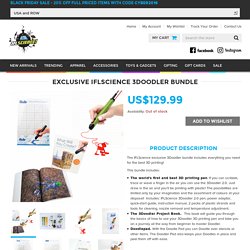
This bundle includes: The world's first and best 3D printing pen. If you can scribble, trace or wave a finger in the air you can use the 3Doodler 2.0. Bioengineers Describe Potential Applications of 3D Printing Trending. 3D printing technology has incredible potential and there seems to be very few limits to its application as scientists refine and improve the technique.

While it can currently be used to make custom prosthetic devices, bioengineers want to take it a step further and create cellular materials. Possible uses include specialized cartilage, bone or skin or possibly simple, whole organs like bladders.A new special issue of Trends in Biotechnology is dedicated to biofabrication – the use of biological materials to construct biological therapeutics, products or systems. Scientists take a moment to consider the state of the science as well as where it could lead in the future, and in the video above, you can take a look inside a biofabrication lab.
Smart Dust Is Coming: New Camera Is the Size of a Grain of Salt. Miniaturization is one of the most world-shaking trends of the last several decades.
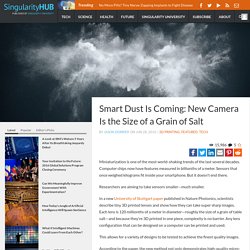
Computer chips now have features measured in billionths of a meter. Sensors that once weighed kilograms fit inside your smartphone. But it doesn't end there. Researchers are aiming to take sensors smaller—much smaller. This $99 Gadget Turns Your Smartphone Into A 3D Printer. 3D printers have been set for big things for a long time.
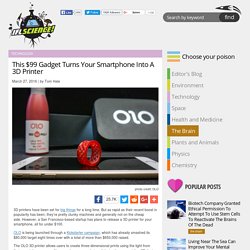
But as rapid as their recent boost in popularity has been, they’re pretty clunky machines and generally not on the cheap side. However, a San Francisco-based startup has plans to release a 3D printer for your smartphone, all for under $100. OLO is being launched through a Kickstarter campaign, which has already smashed its $80,000 target eight times over with a total of more than $650,000 raised. The OLO 3D printer allows users to create three-dimensional prints using the light from their smartphone screen. You can choose your choice of design from an existing 3D design platform that is compatible with the OLO app.
Check out the video at the bottom for more of an insight into how the printer works. Image credit: OLO/YouTube/MakeGIF The start-up also have plans to link the whole experience to social media, allowing users to share their raw designs and images of their final products with others. Photo Gallery. Scientists 3D Print Human-Scale, Living Tissues. Need some new muscle?
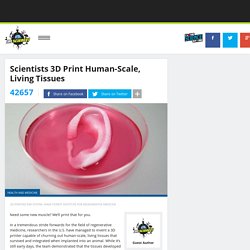
We’ll print that for you. In a tremendous stride forwards for the field of regenerative medicine, researchers in the U.S. have managed to invent a 3D printer capable of churning out human-scale, living tissues that survived and integrated when implanted into an animal. While it’s still early days, the team demonstrated that the tissues developed the right strength and function required for human application, raising the possibility that the technique could one day be used to help people whose tissue has been damaged by disease or trauma. The research is published in the journal Nature Biotechnology. “We know from other industries that 3D printers can print objects of any size and shape,” senior author Anthony Atala from the Wake Forest Institute for Regenerative Medicine told IFLScience. Fully 3D Printed Working Engine Runs Completely on Hot and Cold Water — and You Can Print Your Own For Free. 3D printing is fascinating, especially to those individuals who have not ever seen the technology in action previously.

However, like with all new technology, this fascination subsides as time goes on and the technology becomes more commonplace. Perhaps we aren’t quite at this point yet with 3D printing, but the intrigue generated through the seeing, touching, and feeling of 3D printed objects will surely wither with time. One man in New Zealand, named Don Clucas, realizes this, and with the help of the University of Canterbury, he has come up with a way to fascinate even those already acclimated to 3D printing technology.
3D printing promises to revolutionize just about every facet of our lives and in 2015 that promise came even closer to reality. Researchers Can Now 3D Print Stem Cell "Building Blocks" 3D printing is one of a number of technologies that have bloomed and spread across the world incredibly rapidly in the last decade.
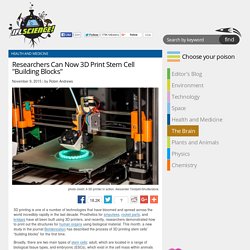
Prosthetics for amputees, rocket parts, and bridges have all been built using 3D printers, and recently, researchers demonstrated how to print out the structures for human organs using biological material. This month, a new study in the journal Biofabrication has described the process of 3D printing stem cells' “building blocks” for the first time. Broadly, there are two main types of stem cells: adult, which are located in a range of biological tissue types, and embryonic (ESCs), which exist in the cell mass within animals that subsequently develops into an embryo.
Researchers Can Now 3D Print A Human Heart Using Biological Material. 3D printing technology can construct actual, working bridges on Earth, build elaborate decorative accessories for your home, produce prosthetics for amputees, and (unfortunately) manufacture working firearms. Although impressive, all these innovations have something in common: they are only producing inorganic, plastic-based material. What about organic materials, say, perhaps, human organs?
These Robots Will 3D Print a Steel Bridge Over a Canal in Amsterdam. 3D printing is stuck in a box. Most of the printers on the market are relatively small, and the scale of objects is limited by the print area. This is acceptable for parts, tools, or toys. But let’s say you want to print something bigger—like a building. You could scale the box up and print it piece by piece, assembling the pieces on site. Newly Developed 3D Printer Can Print With Ten Different Materials. Up until now, most uses of 3D printers have been to create plastic objects, although technology is advancing at such a pace that scientists have managed to print metal, concrete and even glass. But one persistent problem has been printing multiple materials from the same machine. Now researchers at MIT have announced they’ve managed to build a printer that can print an unprecedented 10 different materials. Not only that, but the “MultiFab” 3D printer will make the process better, cheaper, and more user-friendly, claim its creators.
Working at an impressive resolution of just 40 microns, it is also able to quite amazingly self-calibrate and self-correct. This means that if, during printing, the machine realizes that things aren’t quite level, it can go back and add material to where it has decided it's necessary. Scientists are Working on Developing a Star-Trek Style Replicator. Who has never dreamt of having a machine that can materialise any object we need out of thin air at the push of a button?
Such machines only exist in the minds of science fiction enthusiasts and the film industry. The most obvious example is the “replicator” that Star Trek characters routinely use to generate a diverse range of objects, helping them escape from even the most impossible of plotlines. Joseph DeSimone: What if 3D printing was 100x faster?
A Bonafide Molecule 3D Printer. World’s tallest 3D-printed building showcased in China. A Chinese engineering and design firm has unveiled the world’s tallest 3D-printed building - a five-storey residential apartment block made from recycled construction materials. The building was made by the Shanghai-based company called WinSun Decoration Design Engineering. The company's epic custom-built 3D printer cost roughly US$2.3 million and took the company 12 years to manufacture. It measures 6.6 metres tall, 10 metres wide and about 150 metres long - and something just like it may very well print your future home.
The machine works by printing, layer by layer, large sections of buildings (such as wall panels) using an “ink” made from a mixture of fibreglass, steel, cement, hardening agents and recycled construction materials. These sections are then assembled on site, much like prefabricated concrete, to create the final structure. 3D Printed Electronic Devices Are Coming. 3D Printed Electronic Devices Are Coming The handheld computers we carry in our pockets represent almost unimaginable complexity. Batteries, sensors, chips, circuits, and touch displays in a space age shell, all painstakingly assembled by thousands of workers and shipped globally. Smartphones have disrupted numerous industries. Andras Forgacs: Leather and meat without killing animals. MIT: Synthetic DNA Can Be Used as Ink for Nanoscale 3D Printers.
This enables medical applications and nanomaterials. Avi Reichental: What’s next in 3D printing. 3D Printer Builds Homes From Mud In Impoverished Areas. Nearly one billion people around the globe are homeless or live in substandard housing. In the era of 3D printing, some have addressed this crisis through quickly built concrete buildings.
3D Printer Delivered to Space Station Launching New Era of Space Manufacturing. 12-Year-Old Receives First 3D Printed Vertebra Implant. 3D Scanner Digitally Immortalizes Invaluable Masterpieces in Five Minutes Flat. Last year, the Smithsonian opened a virtual museum. La première imprimante 3D pour la maison. Robots Could Use 3D Printing To Build Mars Bases Before Astronauts Arrive. NASA and other private corporations are committed to sending humans to Mars in the relatively near future. After traveling for about 9 months to reach the Red Planet, those pioneering astronauts will want to get right to work with establishing the colony and exploring the planet.
Using 3D Printing and Design To Change the Way We Look at Disability. Scientists Use 3D Printing To Produce Blood Vessels. 3D Printed Body Parts Go Mainstream. 3D printing technology has been around for two decades, but the price has come down in recent years and more people have been able to make use of it. Consequently, we've started to be able to really tap into its vast potential. 3D printed products are being spewed out left, right and center; from the building blocks of houses to replica shark skin.
It almost seems as though the capabilities are endless, and the technology is not anticipated to slow down any time soon. One really exciting application of 3D printing is the generation of body parts. Intelligence™: Patentability of 3D-Printed Organs. L'impression 3D, la fabrication de demain ? Using 3D Printers To Generate Villages Of Houses.